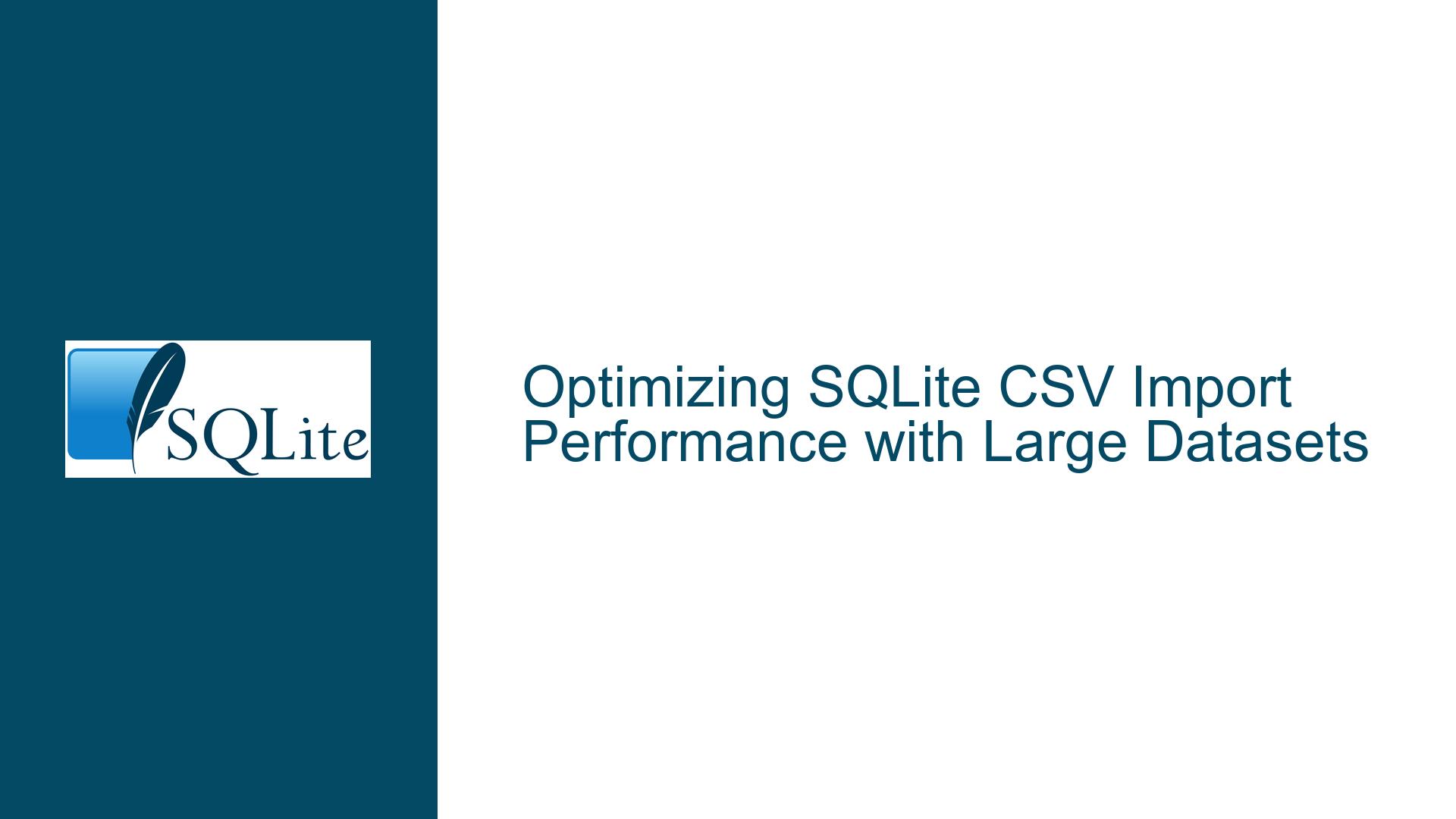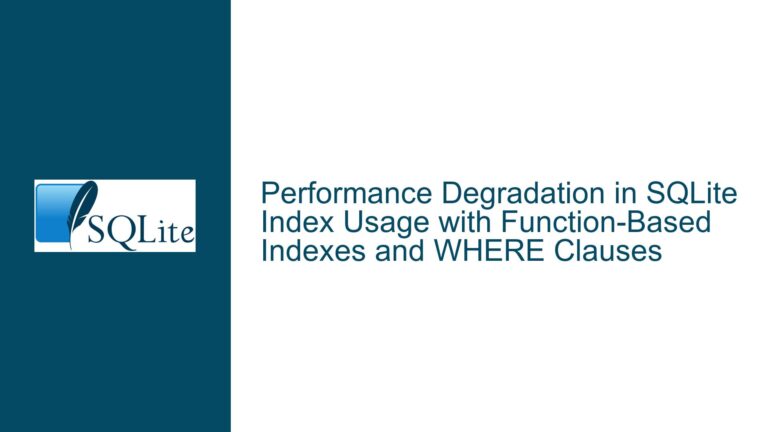Optimizing SQLite CSV Import Performance with Large Datasets
Slow Import of CSV Files into SQLite with Primary Key Constraints
When importing large CSV files into SQLite, particularly those exceeding 30GB with around 100 million records, performance can significantly degrade, especially during the second phase of a two-step import process. The first step, which involves importing the CSV data into a temporary table with all columns as TEXT, is relatively fast, taking around 20 minutes. However, the second step, which involves creating a final table with the correct schema, including PRIMARY KEY and other constraints, and then inserting data from the temporary table into this final table, becomes increasingly slow as the database grows. This slowdown is primarily due to the enforcement of PRIMARY KEY uniqueness during the insertion process.
The PRIMARY KEY constraint ensures that each value in the specified column(s) is unique, which requires SQLite to continuously check and maintain the index structure as new records are inserted. This process can be particularly slow if the data is not inserted in the order of the PRIMARY KEY, leading to frequent rebalancing of the B-Tree index. Additionally, the default cache size in SQLite is relatively small (around 2MB), which can exacerbate the problem by causing excessive disk I/O as pages are repeatedly read and written.
Interrupted Write Operations Leading to Index Corruption
One of the primary causes of the slowdown during the second step of the CSV import process is the enforcement of the PRIMARY KEY constraint. When data is inserted into a table with a PRIMARY KEY, SQLite must ensure that each new record does not violate the uniqueness constraint. This involves checking the index for the presence of the new key and updating the index structure if necessary. If the data is not inserted in the order of the PRIMARY KEY, the index must be frequently rebalanced, which can be a time-consuming operation.
Another factor contributing to the slowdown is the size of the SQLite cache. The default cache size is set to -2000, which corresponds to approximately 2MB. This small cache size can lead to "thrashing," where the same pages are repeatedly read from and written to disk as the index is updated. This thrashing can significantly increase the amount of disk I/O, further slowing down the import process.
Additionally, the use of transactions can impact performance. If transactions are not used during the import process, SQLite will commit each individual insert operation, which can lead to a significant amount of disk I/O. By wrapping the insert operations in a transaction, the number of disk writes can be reduced, improving performance.
Implementing PRAGMA journal_mode and Database Backup
To optimize the import process, several strategies can be employed. First, consider increasing the cache size using the PRAGMA cache_size command. A larger cache size can reduce the amount of disk I/O by allowing more pages to be held in memory. For example, setting the cache size to -1000000 (approximately 1GB) can significantly improve performance, especially when dealing with large datasets.
Another strategy is to disable disk synchronization during the import process using the PRAGMA synchronous command. Setting PRAGMA synchronous to OFF can reduce the number of disk writes, speeding up the import process. However, this should be done with caution, as it can increase the risk of database corruption in the event of a power failure or system crash. After the import is complete, PRAGMA synchronous should be set back to its default value.
Using transactions can also improve performance. By wrapping the insert operations in a transaction, the number of disk writes can be reduced, as SQLite will only commit the transaction once all the inserts have been completed. This can significantly reduce the amount of disk I/O and improve overall performance.
In addition to these strategies, consider the order in which data is inserted. If the data is inserted in the order of the PRIMARY KEY, the index can be built more efficiently, reducing the need for frequent rebalancing. If the data is not already sorted, it may be beneficial to sort it before inserting it into the final table.
Finally, consider deferring the creation of the PRIMARY KEY and other constraints until after the data has been imported. Instead of creating the final table with all constraints in place, create a temporary table without any constraints, import the data into this table, and then create the final table with the correct schema and constraints. After the data has been imported, use the CREATE UNIQUE INDEX command to create the necessary indexes. This approach can significantly speed up the import process, as the indexes will be built in a single pass after all the data has been inserted.
Detailed Steps for Optimized CSV Import
Import CSV into a Temporary Table: Begin by importing the CSV data into a temporary table with all columns as TEXT. This step is relatively fast and does not involve any constraints.
.import 'large.csv' QQQ_1Create a Temporary Table with Proper Types: Create a second temporary table with the correct column types but without any PRIMARY KEY or UNIQUE constraints.
CREATE TABLE QQQ_2 ( column1 TEXT, column2 REAL, column3 INTEGER, ... );Set Cache Size and Disable Synchronization: Increase the cache size and disable disk synchronization to improve performance during the data transfer.
PRAGMA cache_size = -1000000; -- Set cache to 1GB PRAGMA synchronous = OFF;Insert Data into the Temporary Table: Transfer the data from the first temporary table to the second temporary table.
INSERT INTO QQQ_2 SELECT * FROM QQQ_1;Create Unique Indexes: After the data has been inserted, create the necessary UNIQUE indexes to enforce the PRIMARY KEY and other constraints.
CREATE UNIQUE INDEX idx_qqq2_pk ON QQQ_2 (column1);Create the Final Table with Constraints: Create the final table with the correct schema, including PRIMARY KEY and other constraints.
CREATE TABLE official ( column1 TEXT PRIMARY KEY, column2 REAL, column3 INTEGER, ... );Insert Data into the Final Table: Insert the data from the second temporary table into the final table, ensuring that the data is ordered by the PRIMARY KEY.
INSERT INTO official SELECT * FROM QQQ_2 ORDER BY column1;Re-enable Synchronization and Clean Up: Re-enable disk synchronization and clean up the temporary tables.
PRAGMA synchronous = NORMAL; DROP TABLE QQQ_1; DROP TABLE QQQ_2;
Performance Considerations
Cache Size: Increasing the cache size can significantly reduce disk I/O, especially when dealing with large datasets. A cache size of 1GB or more is recommended for datasets exceeding 30GB.
Disk Synchronization: Disabling disk synchronization during the import process can improve performance, but it should be done with caution. Always re-enable synchronization after the import is complete to ensure data integrity.
Transactions: Using transactions can reduce the number of disk writes, improving performance. Wrap the insert operations in a transaction to minimize disk I/O.
Data Order: Inserting data in the order of the PRIMARY KEY can improve index construction efficiency. If the data is not already sorted, consider sorting it before insertion.
Deferred Index Creation: Deferring the creation of indexes until after the data has been imported can significantly speed up the import process. Use the CREATE UNIQUE INDEX command to create indexes after the data has been inserted.
Conclusion
Optimizing the import of large CSV files into SQLite requires careful consideration of several factors, including cache size, disk synchronization, transaction usage, and the order of data insertion. By following the steps outlined above, you can significantly improve the performance of the import process, reducing the time required to import large datasets from hours to minutes. Additionally, deferring the creation of indexes until after the data has been imported can further enhance performance, ensuring that your SQLite database is ready for use as quickly as possible.






